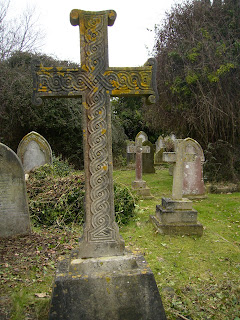


Yet another new site for the Green Gym this week in Mornington Road Cowes, with an excellent turnout on a mild, dry day. This area has been designated as a village green, but has been very neglected for some time, suffering from litter, dumping of garden refuse and other mess. The plan is to let more light into the area, keep it clean and tidy with better access, and possible generate a wetland area at the bottom of the site, which is very steep with lots of water run off. There were many tasks to keep us occupied including coppicing, opening pathways, clearing and restoring steps, litter picking. There is a very interesting structure at the top of the site with a round shape , next to a metal cover and what looks like a tunnel behind which they have been unable to identify, but Mark (Earp) may have solved this for them.
Mark's History Lesson.


The old maps show there are two of these structures in the area, one at Northwood and this may be the other - a bell jar reservoir (a bit like an upside down bell) and ice well. The curved part which is visible is the rounded part of the bell with a square opening at the top, and these type of ice houses were normally built on north facing areas (which this is) and used to store foodstuffs such as cheese, wine etc. They were usually attached to big manor houses owned by wealthy families, and the tunnel at the back may be another access route into the reservoir. The structure with the metal cover next to the bell jar is the ice well which was filled with cold water and ice. The bricks used in the construction date from the 1780’s to 1860’s, which can be identified by their colour and construction and may have been made locally, as there were many brickworks on the Island during this period.












